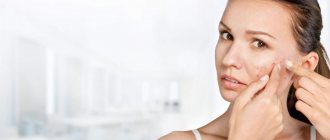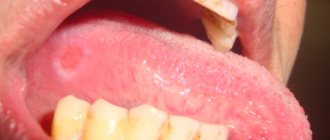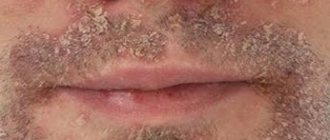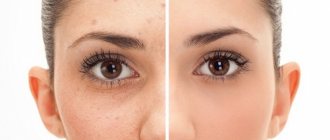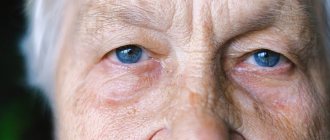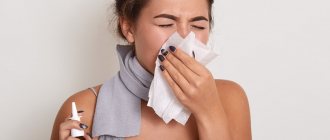Age spots are dark spots that range in color from light brown to dark brown. They appear for several reasons, including: the effects of sunburn, age-related changes, abuse of cosmetics, hormonal changes, side effects from medications.
Typically, age spots are considered an aesthetic defect. In most cases, age spots cause dry skin, increased wrinkles and dilated blood vessels. Although age spots are not malignant neoplasms, they serve as an excellent camouflage for the latter (since it is almost impossible to see a neoplasm in the area of an age spot with the naked eye).
Many people try in different ways to get rid of age spots , in this article we will look at: types of age spots, methods of getting rid of them, the need to consult a doctor (in this case an endocrinologist), the effectiveness of procedures and contraindications.
- Exposure to ultraviolet rays
- Using phototherapy
- Indications
What are age spots?
A cosmetic defect in the form of flat areas darker than the main area of the skin appears due to increased melanin synthesis in specific areas. Age spots can appear at birth or develop throughout life. Elements are responsible for skin tone, each of which has its own function:
- melanin – protects against the negative effects of ultraviolet radiation, has antioxidant properties, is involved in eliminating the effects of stress, and reduces the activity of free radicals;
- carotene – ensures cell regeneration, slows down the aging process;
- hemoglobins - blue and oxyhemoglobin are designed to color the blood and are responsible for a healthy glow and natural skin color.
Increased pigmentation is the result of excess melanin. Most often, pigmentation is observed in the form of freckles, which are associated with a genetic factor or exposure to ultraviolet radiation.
Freckles are more common on the face, décolleté, back and forearms. Less commonly they cover the hands. They can be very small in size or merge into conglomerations, forming large areas of hyperpigmentation. Red-haired people with fair skin are prone to freckles. In winter the spots become paler, in summer they become brighter. They do not pose a health hazard, it is just a cosmetic flaw from the point of view of some people, and a “highlight” in the opinion of others.
There are also other types of pigmentation, some of them are dangerous in terms of degeneration into malignant neoplasms:
- Nevi and birthmarks are an uneven distribution of melanin in skin cells. The shade varies from light pink to dark brown. They are not particularly dangerous until they begin to change their structure. Birthmarks on the face, visible areas and areas subject to friction are best removed.
- Melasma, chloasma without sharply defined boundaries on the face, neck, shoulders. Associated with problems of the hormonal system. Eliminated using cosmetic procedures.
- Lentigo – age-related pigmentation, age spots. Most often they cover the upper body. They are poorly masked by cosmetics, but it is possible to reduce their intensity with the help of salon procedures.
- Hypopigmentation includes vitiligo and albinism - discolored areas of the skin.
Pigmentation is dermal, forming in the deep layers of the epidermis. And epidermal, which affects the upper layers of the skin.
Diagnostics
To accurately determine the type of hypermelanosis, as well as to identify effective means of control, you need to contact a dermatologist. At the initial visit, the doctor will collect the patient's medical history to determine the most likely internal and external factors that will indicate a certain type of disorder. He will examine the skin and also prescribe a number of tests:
- AOK and OAM;
- blood biochemistry;
- Wood's lamp tests;
- scraping;
- biopsy.
If a malignant neoplasm or fungal infection is suspected, referrals will be given for the last two procedures on the list. As a result, the specialist will be able to accurately determine the type of illness and prescribe therapeutic or cosmetic procedures.
Anti-age drugs
Bb Laboratories – Hyaluron-elastin-collagen extract
Laennec – solution for injection
Curacen Essence (20 fl x 2 ml)
Two-phase placental serum concentrate
Causes of age spots on the face
Cosmetic flaw occurs in women, men and even newborn children. There are several reasons for pigmentation:
- frequent and intense exposure to ultraviolet radiation on the skin - disrupts cell structure, inhibits regeneration, destroys collagen fibers;
- trauma - scratches, abrasions, cuts, hematomas can activate the production of melanin in a certain area;
- hormonal imbalance - during puberty, during pregnancy, menstruation, menopause;
- pathologies of internal organs - most often the adrenal glands, liver, gall and thyroid glands;
- skin diseases, especially acne;
- taking certain medications with photosensitivity effects;
- poor circulation in the extremities;
- diseases of the reproductive system;
- infections, viruses, bacteria, fungal pathologies;
- heredity.
In newborns, pigment spots may appear due to the difficulties of the mother's delivery. Most of them go away on their own in the first year of life, but all formations require monitoring.
Table of contents
- Etiology and pathogenesis
- Clinical manifestations
- Principles of treatment
Abnormal skin pigmentation on the face and body is a group of dermatological diseases/conditions that manifest as local or generalized changes in skin color, most often darkening.
In our company you can purchase the following equipment for the treatment of removal of abnormal skin pigmentation:
- M22 (Lumenis)
How to remove pigment spots on the face from a cosmetologist
Aesthetic medicine provides a variety of techniques for removing defects. But before determining the method of influencing the pigment spot, the cosmetologist must conduct an examination. Consultations with specialized doctors may be required: endocrinologist, gynecologist, dermatologist, venereologist. Techniques for removing age spots in specialized institutions:
- chemical exfoliation (peeling) with preparations based on fruit acids - activates metabolic processes, cleanses the skin, evenly discolors spots, restores velvety;
- photorejuvenation – reduction of pigmentation brightness, cell regeneration, brightening effect;
- microdermabrasion - soft grinding of the surface layer of the skin, evens out and brightens the tone, improves microcirculation;
- cryotherapy - exposure to cold using liquid nitrogen, is more applicable for eliminating nevi and severe pigmentation;
- mesotherapy is an injection method of lightening with preparations containing peptides;
- Laser therapy is a painless procedure for eliminating pigmentation, suitable for treating large areas and intensely colored spots.
Any cosmetological technique requires preparation and compliance with the rules of care after manipulation. In some cases, one procedure is enough, in others, 3 to 5 sessions are required.
Before and after results
Telos Beauty Clinic specialists prof. They have been eliminating age spots for more than 12 years and have accumulated extensive practical experience, which allows them to carry out comprehensive treatment of pigmentation to help each patient.
Don’t be ashamed of yourself, because in order to transform, you only need to take one step and sign up for a consultation at our clinic.
How to remove pigmentation on the face at home using cosmetics
If the spots are not intense and do not occupy large areas, you can make them lighter yourself. Pharmaceutical products and skincare products are suitable for this:
- Hydroquinone, lavender oil, hydrogen peroxide, and resorcinol have an exfoliating and keratolytic effect.
- Weak fruit acids, which can be used at home, work well to whiten stains. This is citric, ascorbic, and lactic acid of low concentration. These products are also suitable for preparing for salon chemical peels.
- Lightening cosmetic compositions marked Anti-Pigment. Creams, lotions and serums containing azelaine, kojic acid, vitamin C.
Any product can be used only after testing for possible allergies. If the body accepts the composition calmly, without a negative reaction, you can begin the procedures according to the instructions for the drug.
Is it possible to remove age spots on the face using folk remedies?
If the pigmentation is severe, only a professional cosmetologist will help you get rid of it. Small, dim spots and freckles can be easily lightened with the help of components that are always on hand:
- lemon;
- parsley extract;
- cottage cheese, whey and yogurt;
- cucumber;
- potato;
- buckwheat and oat flour;
- Apple vinegar;
- aloe vera;
- cosmetic clay;
- milk;
- strong infusion of green tea;
- licorice extract, orchid extract and so on.
The components can be mixed, pharmaceuticals and vitamins can be added. After the whitening procedure, it is imperative to take care of moisturizing and softening the skin.
How to prevent the appearance of age spots?
If the cause of pigmentation does not lie in a hereditary factor, a cosmetic defect can be avoided. Preventive measures:
- do not develop diseases of internal organs - be sure to undergo routine examinations with doctors twice a year;
- do not get carried away with tanning - both in the sun and in the solarium;
- take care of skin protection - go outside in winter, after applying cream with SPF 30, in summer the indicator should be 50;
- choose wisely skincare products to maintain a beautiful and even skin tone;
- maintain a drinking regime - do not let the skin dry out;
- monitor hygiene, prevent the development of acne and the formation of comedones;
- control hormonal levels.
It is also important to take care of prevention long before the period of wilting. The sooner sufficient attention is paid to care and protection, the later the skin will undergo age-related changes. Pigment spots are a phenomenon that can and should be combated. Don’t give up if home treatments don’t bring results; you can always turn to a cosmetologist for help.
Prevention
The first and main preventive measure is proper protection from the harmful effects of direct sunlight. It is worth remembering that you can safely stay under ultraviolet light for no more than 10-15 minutes, after which the risk of getting a burn increases significantly. You should always apply sunscreen to prevent problems.
The second thing that should not be forgotten is regular health checks. Don’t be afraid to visit a doctor, get tested and find out your current condition. After all, it is much easier to prevent a problem than to deal with it later. It won’t hurt to change your clothes to natural ones, throw out chafing and tight things, and lead a healthy lifestyle.
